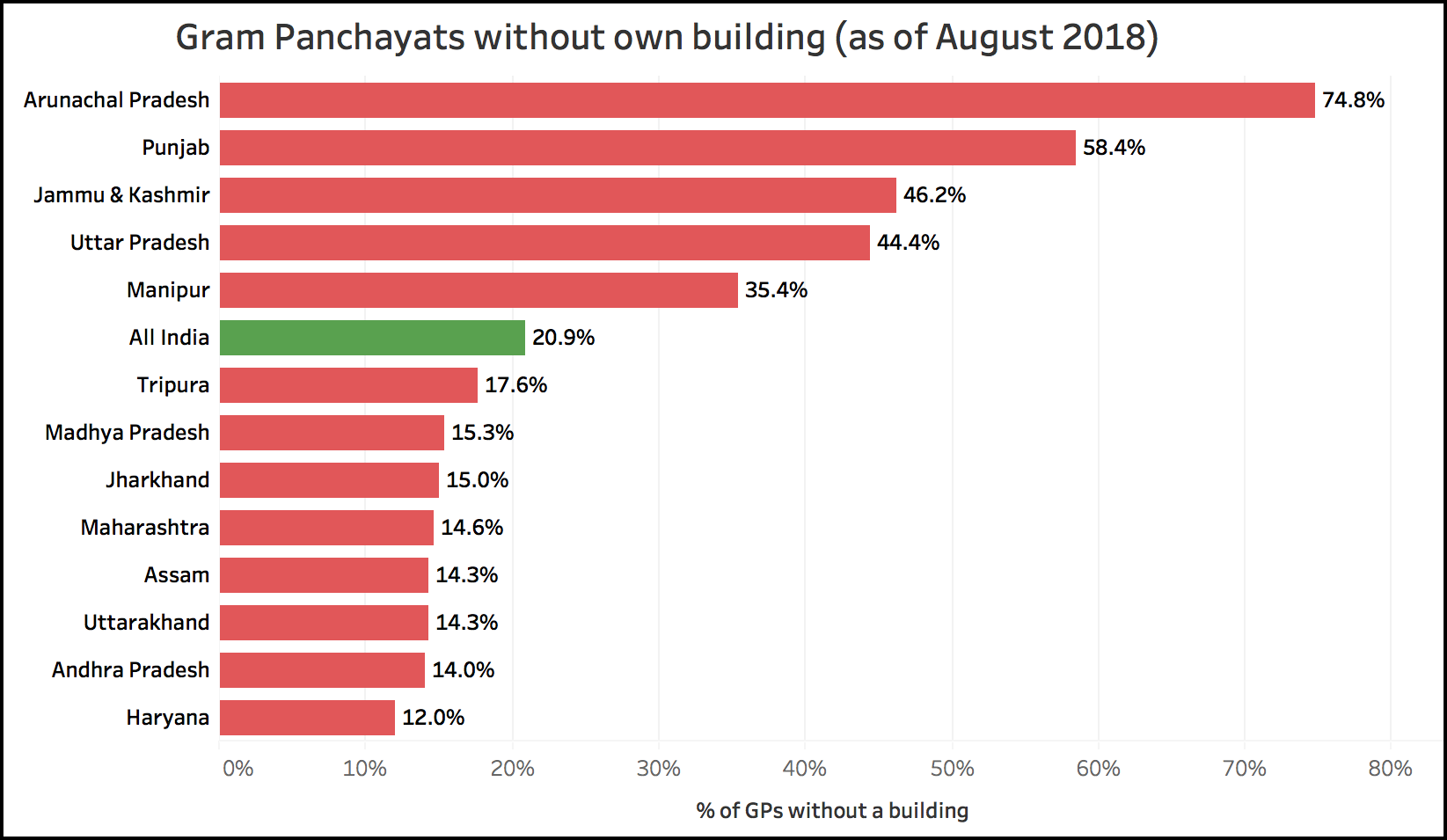[orc]As per the latest data shared in the Lok Sabha, more than 52000 Gram Panchayats do not have a building of their own out of the 2.48 lakh GPs in the country. In four states, at least 40% of the GPs are without own building.
Gram Panchayat is the lowest tier of governance in India where the elected representatives are most approachable & closest to the rural citizenry. Thus the Panchayat institution is a very important cog in the governance wheel and its efficient functioning has the potential to bring in transformative change. Panchayats have in general suffered from lack of funds despite the 73rd constitutional amendment mandating transfer of certain functions, funds & functionaries to the panchayats. As per the data shared by the government in the Lok Sabha, more than 52000 Panchayats (21%) do not have a building of their own. In the last 2 years, only 5000 odd new panchayat buildings were constructed.
What are the Central schemes for Infrastructure support to Panchayats?
As per the constitution, Panchayat is a state subject meaning the State Governments are primarily responsible for creation of infrastructure in the panchayats. However, there have been various central sector schemes that extended support for infrastructure creation in the panchayats.
The Rajiv Gandhi Panchayat Sashaktikaran Abhiyan (RGPSA) was launched in 2013 to strengthen the Panchayati Raj system across the country and address critical gaps that constrain its success. The scheme was launched to address the following issues
- Enhance capacities and effectiveness of Panchayats and the Gram Sabhas
- Enable democratic decision-making and accountability in Panchayats and promote people’s participation
- Strengthen the institutional structure for knowledge creation and capacity building of Panchayats
- Promote devolution of powers and responsibilities to Panchayats according to the spirit of the Constitution and PESA Act
- Strengthen Gram Sabhas to function effectively as the basic forum of people’s participation, transparency and accountability within the Panchayat system
- Create and strengthen democratic local self-government in areas where Panchayats do not exist
- Strengthen the constitutionally mandated framework on which Panchayats are founded
One of the activities included in the state plan of this scheme is funding for the construction of Gram Panchayat (GP) buildings. The scheme was implemented from 2012-13 to 2015-16 while financial assistance was provided to States for construction of Panchayat buildings up to 2015-16. No new funds were provided under this scheme in 2016-17 & 2017-18.
The current NDA government launched a new Centrally Sponsored Scheme (CSS) scheme of Rashtriya Gram Swaraj Abhiyan (RGSA), to be implemented from 2018-19 to 2021-22. This scheme also envisages assistance to States for construction of Panchayat Bhawans. The new scheme, as per the government’s official website aims at bridging the gaps in the following areas.
- Capacity Building and Training (CB&T)
- Gram Panchayat infrastructure
- Use of IT for distance learning & for e-Enablement of Panchayats
- Institutional support for innovations
- Gap filling support of economic development & income enhancement
- Technical support including Human Resource (HR) based on identified gaps
- To provide handholding support by Academic Institutions/ Institutions of excellence to GPs for Gram Panchayat Development Plan (GPDP) formulation
- To promote provision of adequate manpower at GP level & to provide support for technical manpower
- To support greater e-enablement of Panchayats for e-governance to enhance efficiency and transparency with thrust on Panchayat Enterprise Suite (PES) Applications developed by the Ministry
- To facilitate Electronic Fund Transfer (EFT), Public Finance Management System (PFMS), use and Geotagging of assets in Gram Panchayats
Like in the case of RGPSA, the scheme envisages construction of new buildings for panchayats, repair of existing buildings, additional rooms in the building for a common service center, construction of toilets in existing buildings, providing barrier free entry to persons with disabilities etc. As per the scheme guidelines, preference would be given to antyodaya GPs and GPs in aspirational districts. The following cost norms would be applicable
- Rs 20 lakh for GP building with Community Hall
- Rs 4 lakh for additional room for co-locating Common Service Centres (CSC)
- Rs 4 lakh for renovation of GP building including repairs etc.
Though the scheme document earmarks Rs 270 crore in 2018-19 for panchayat buildings, no such allocation has been made in the 2018-19 budget.
More than 40% GPs in Uttar Pradesh do not have own building
As per the data shared in the Lok Sabha, more than 52000 GPs do not have a building of their own out of the 2.48 lakh GPs in the country. In other words, 21% of the GPs do not have a building of their own. Leading this list is the state of Uttar Pradesh where more than 26000 GPs are without a building. This is 44% of the total GPs in Uttar Pradesh. Apart from Uttar Pradesh, more than 40% of the GPs are without own building in the states of Arunachal Pradesh, Punjab and Jammu & Kashmir. Every GP has own building in the states of Tamil Nadu, Himachal Pradesh, Gujarat, Goa, Chhattisgarh. In 13 States/UTs, less than 10% of the GPs are without own building.

Featured image source:By Gazal Aga (Own work) [CC BY-SA 3.0], via Wikimedia Commons


